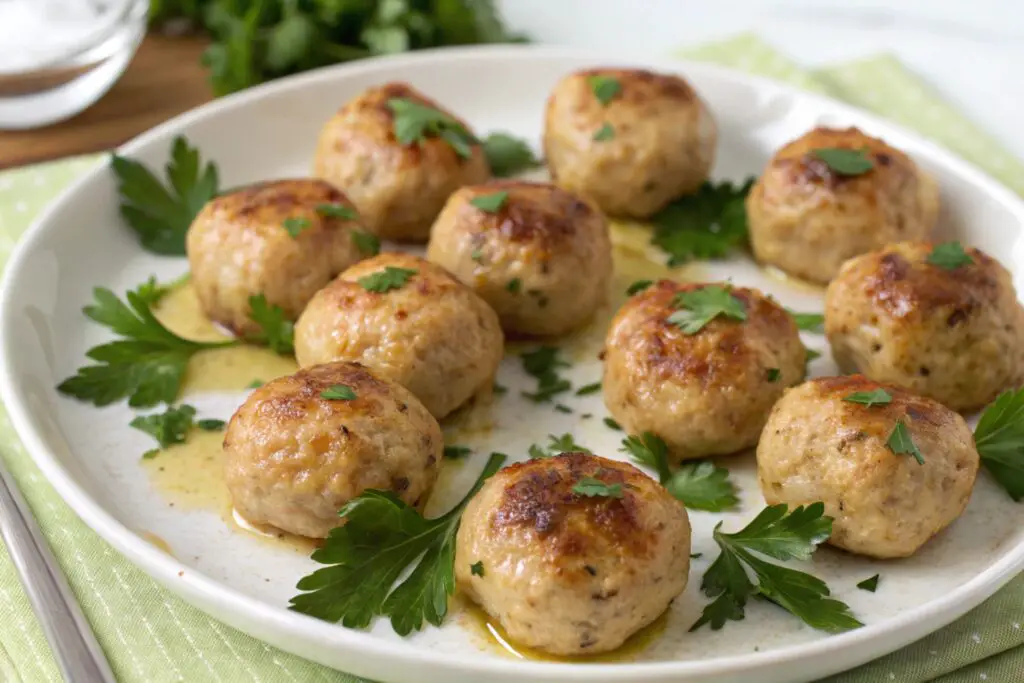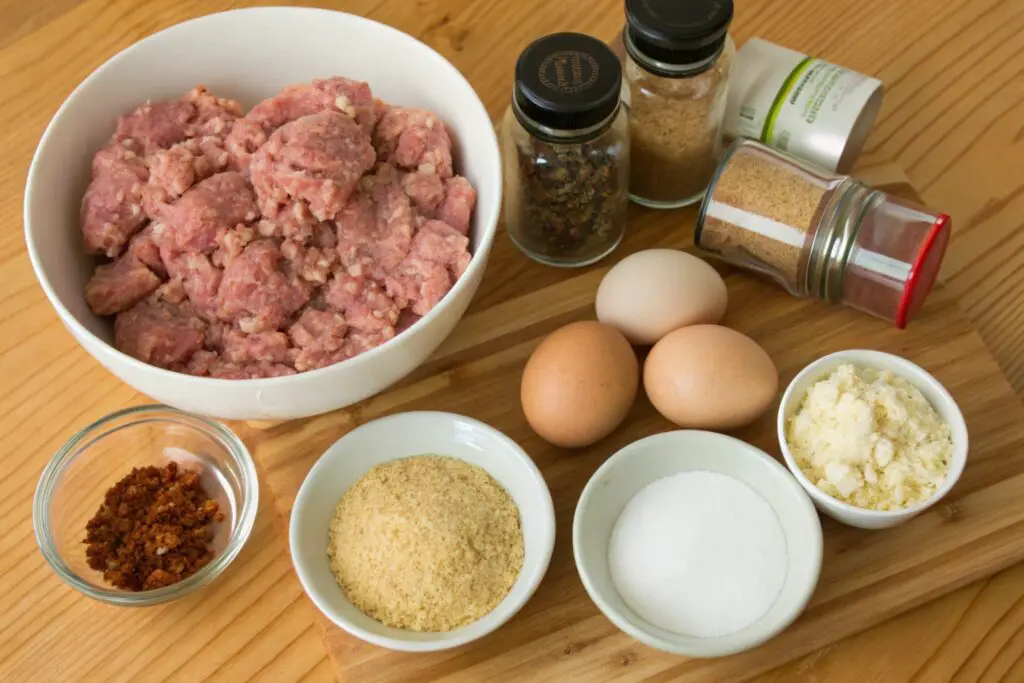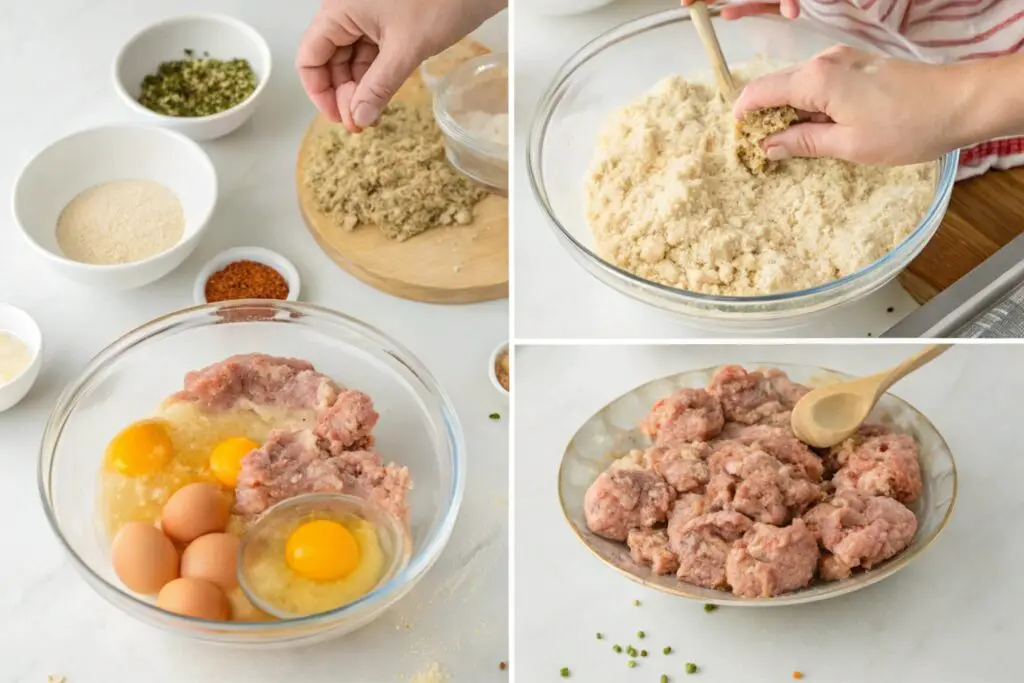You’ve spent time carefully preparing your homemade chicken meatballs, excited to serve them up for a cozy family dinner. The aroma fills the kitchen, your sauce is simmering to perfection, and anticipation builds. But as you take the first bite… something feels off. Instead of that juicy, tender texture you imagined, they feel spongy and oddly chewy. Disappointment sets in, and you ask yourself, “What went wrong?”
Trust me, you’re not alone! Many home cooks struggle with chicken meatballs turning out too soft, rubbery, or strangely bouncy. Unlike beef or pork, ground chicken has a different texture and moisture content, which means small mistakes can drastically affect the final result. Why are my chicken meatballs.
Good news? Spongy chicken meatballs aren’t a lost cause! The reasons behind this problem are simple, and once you know them, you’ll never have to suffer through an unpleasant batch again. 🏆

Table of Contents
Common Reasons Why Chicken Meatballs Turn Out Spongy
Before we dive into the fixes, let’s uncover the most common reasons why your chicken meatballs might have that odd, bouncy texture. These mistakes are easy to make, but thankfully, they’re just as easy to correct. 😉
1. Overmixing the Meat Mixture 🌀
One of the biggest culprits behind spongy chicken meatballs is overmixing. When ground chicken is stirred too much, the proteins get overworked, creating a dense, rubbery texture instead of a light and tender one.
Think of it like kneading bread dough—the more you mix, the tougher it gets. The same rule applies to meatballs!
Chicken already has a finer texture compared to beef, so it requires minimal handling. If you’ve been aggressively stirring the mixture, it’s time to dial it back. Mixing just until the ingredients are combined is all you need.
2. Too Many Binders (Eggs, Breadcrumbs, or Flour) 🥖
Bread crumbs, eggs, and flour are often added to meatballs to help hold them together. But too much of a good thing can backfire! Excessive binders can cause the meatballs to feel doughy and spongy instead of light and juicy.
Ideal Binder Ratios:
| Ingredient | Recommended Amount per 1 lb of Ground Chicken |
|---|---|
| Egg | 1 small egg (or half a large one) |
| Bread Crumbs | 1/4 to 1/3 cup |
| Flour or Cornstarch | 1 tbsp (optional) |
If you’ve been tossing in extra eggs or breadcrumbs to “help” with consistency, you might actually be causing the opposite effect. A little goes a long way! 🍳
3. Using the Wrong Ground Chicken Ratio (Too Lean or Too Fatty) 🐔
Ground chicken varies in fat content, and choosing the wrong blend can drastically affect texture. If your meat is too lean (99% fat-free), the lack of fat can make the meatballs dry and rubbery. On the other hand, if it’s too fatty, it can create a strange, loose, or sponge-like consistency.

Best Choice? A blend of 85% lean / 15% fat or 80% lean / 20% fat works best for soft yet juicy meatballs.
If you’ve been using ultra-lean ground chicken, consider mixing in a small amount of finely chopped chicken thighs for better texture.
4. Excessive Moisture in the Mixture 💦
Chicken naturally contains a lot of water. If you’ve ever worked with ground chicken, you may have noticed that it gets sticky and wet. Adding additional moisture-heavy ingredients like grated onions, soaked breadcrumbs, or milk can push things over the edge.
Too much moisture = spongy meatballs. Simple as that.
5. Not Enough Seasoning or Enhancing Ingredients 🧂
Seasoning doesn’t just affect taste—it also impacts texture. When chicken meatballs lack enough spices, herbs, and umami boosters, they can feel flat and lifeless in both flavor and structure.
Try adding:
- Fresh herbs (parsley, basil, or cilantro)
- Grated Parmesan cheese (for umami depth)
- Minced garlic or onion (for aromatic richness)
- A dash of Worcestershire sauce (for extra meatiness)
Pro Tip: Well-seasoned meatballs hold their shape better and taste incredible. Never underestimate the power of a little garlic and parmesan! 🧄🧀
6. Cooking at the Wrong Temperature (Too High or Too Low) 🔥
Cooking temperature plays a huge role in meatball texture. If the heat is too low, the meatballs steam and develop a soft, sponge-like consistency. If it’s too high, the outside burns while the inside stays undercooked.
Ideal Cooking Temps:
- Baking: 400°F (200°C) for 15-20 minutes
- Pan-frying: Medium heat for 6-8 minutes, turning occasionally
- Simmering in Sauce: Low heat for 20-25 minutes
Finding the right balance ensures your meatballs stay moist but not overly soft.
How to Fix Spongy Chicken Meatballs: Best Solutions
Now that we’ve identified the reasons behind spongy chicken meatballs, let’s get to the good part—fixing them! 🎉
The best part? You don’t have to start over from scratch. With a few tweaks, your next batch of chicken meatballs will be juicy, tender, and packed with flavor. Let’s dive in!
1. Mix Gently and Avoid Overworking the Meat 🌀
The golden rule for making chicken meatballs: handle with care. Overmixing is one of the biggest reasons they turn spongy, so keeping things light and minimal is key.
Fix:
- Use a light touch when mixing—just until the ingredients are combined.
- Try using a fork or your fingertips instead of vigorously stirring with a spoon.
- Chill the mixture for 15–20 minutes before shaping to firm it up.
Pro Tip: If you press the meat too tightly when forming the balls, they’ll turn out dense. Shape them gently for a softer bite! 🏆
2. Balance Your Binder Ingredients 🥚
Eggs and breadcrumbs hold the meatballs together, but too much can create a spongy texture. The key is getting the right balance.
Fix:
- Use 1 small egg per pound of chicken (or half of a large egg).
- Stick to 1/4 to 1/3 cup of breadcrumbs per pound of meat.
- Swap breadcrumbs for grated parmesan or almond flour for a lighter texture.
Pro Tip: If your mixture seems too wet, skip adding extra breadcrumbs. Instead, let the mixture rest for a few minutes so the existing ingredients absorb moisture naturally. ⏳
3. Choose the Right Chicken Blend 🐔
Chicken that’s too lean can be tough, while too much fat can make meatballs fall apart. A balanced mix works best.
Fix:
- Opt for 85/15 or 80/20 ground chicken for the perfect juiciness.
- If using lean ground chicken, mix in grated zucchini or finely diced chicken thighs for moisture.
- Avoid ground chicken breast alone—it’s too dry!
4. Remove Excess Moisture Before Cooking 💦
Too much liquid in the meatball mix can lead to a sponge-like texture. If your mixture feels sticky or too wet, here’s how to fix it.
Fix:
- Pat dry any ingredients that release moisture (onions, herbs, etc.).
- If using grated onions, squeeze out excess liquid before adding.
- Let the meatball mix chill for 20 minutes to firm up.
5. Enhance Flavor with Herbs, Spices, and Aromatics 🌿
Bland meatballs aren’t just a taste issue—seasoning also affects texture. Adding the right mix of flavors will give them better structure and depth.
Fix:
- Use fresh herbs like parsley, oregano, or basil.
- Add a pinch of chili flakes or black pepper for extra depth.
- Include minced garlic and onion for richer flavor.
- Try a dash of Worcestershire sauce or soy sauce for umami.
Pro Tip: Grated parmesan cheese helps bind the mixture while boosting taste. Add 2 tbsp per pound of chicken for a richer texture! 🧀
6. Cook at the Right Temperature and Method 🔥
Spongy meatballs often result from incorrect cooking temperatures. The goal is to cook them evenly—firm but tender, without drying out.
Fix:
| Cooking Method | Best Temperature | Time |
|---|---|---|
| Baking | 400°F (200°C) | 15–20 minutes |
| Pan-frying | Medium heat | 6–8 minutes, turning occasionally |
| Simmering in Sauce | Low heat | 20–25 minutes |
Pro Tip: Use an instant-read thermometer and cook until the center reaches 165°F (74°C) for perfectly juicy meatballs. 🌡️
7. Check Internal Temperature for Perfect Doneness 🌡️
Overcooking dries out meatballs, while undercooking leaves them mushy. Checking the temperature helps you hit the sweet spot every time.
Fix:
- Use a meat thermometer and aim for 165°F (74°C).
- If pan-frying, finish the meatballs in sauce for an extra 5 minutes.
- Let them rest for 5 minutes before serving to lock in juices.
8. Experiment with Different Cooking Methods 🍳
Sometimes, the way you cook meatballs affects their texture. If yours are spongy, switching up the method could make a difference.
Fix:
- If baking, try pan-frying first for a crispier crust.
- If simmering in sauce, sear them first to lock in texture.
- For extra crispy meatballs, air-fry at 375°F (190°C) for 12 minutes.
Pro Tip: Want softer meatballs? Add 1 tbsp of olive oil to the mix for a silkier mouthfeel. 🫒
Final Thoughts on Fixing Why are my chicken meatballs
Spongy chicken meatballs can be frustrating, but they’re 100% fixable! By avoiding overmixing, balancing ingredients, and cooking at the right temperature, you’ll get juicy, flavorful meatballs every time. 🍽️

Pro Tips for Making Perfect Chicken Meatballs
By now, we’ve covered what causes spongy chicken meatballs and the best ways to fix them. But what if you want to go a step further? What if you want restaurant-quality meatballs every single time? 🍽️
Good news: There are some game-changing tricks that professional chefs use to get soft, juicy, and flavorful chicken meatballs. Let’s dive into the pro tips! 🏆
1. Use Cold Ingredients for Better Texture ❄️
One of the biggest mistakes people make when working with ground chicken is using room-temperature ingredients. Since chicken has a softer texture than beef or pork, it can become sticky and hard to work with.
Pro Tip:
- Keep your ground chicken cold before mixing—it helps maintain structure.
- Chill your bowl and utensils in the fridge for 10 minutes before using.
- If the mixture feels too soft, pop it in the fridge for 15–20 minutes before shaping.
Why it works: Cold ingredients prevent the meatballs from becoming mushy and help them hold their shape better. 🚀
2. Test a Small Portion Before Cooking the Whole Batch 🍳
Ever seasoned your meatballs, only to realize they’re bland after they’ve been cooked? There’s an easy way to prevent this.
Pro Tip:
- Take a small spoonful of your meatball mixture and cook it in a pan.
- Taste it and adjust seasoning if needed before shaping the full batch.
- Too dry? Add a bit of olive oil. Too wet? Chill the mixture for a bit.
Why it works: A quick taste test saves you from making a whole batch of bland meatballs! 🏆
3. Consider Adding a Bit of Fat for Juiciness 🫒
Because chicken is leaner than beef or pork, it sometimes lacks the natural fats that keep meatballs tender and juicy.
Pro Tip:
- Add 1 tbsp of olive oil per pound of chicken for extra moisture.
- Mix in grated cheese (like parmesan) for added richness.
- For even more juiciness, stir in a spoonful of Greek yogurt or ricotta cheese.
Why it works: A little extra fat prevents the meatballs from drying out and gives them a luxurious texture. 🍽️
4. Try a Resting Time Before Cooking ⏳
Letting the meatball mixture sit before shaping helps the ingredients bind together properly.
Pro Tip:
- Mix your ingredients and let the mixture rest in the fridge for 20–30 minutes.
- This allows the flavors to meld and firms up the texture.
Why it works: Chilling makes the mixture easier to handle and prevents spongy meatballs. 🔥
5. Don’t Overcrowd the Pan While Cooking 🍳
If you’re pan-frying your meatballs, make sure to give them some space!
Pro Tip:
- Cook meatballs in batches so they brown evenly.
- Overcrowding creates steam, making them soggy instead of crispy.
6. Store and Reheat Properly for the Best Texture 🥡
Leftover chicken meatballs can still taste amazing—if they’re stored correctly!
| Storage Method | Best Practices | How Long It Lasts |
|---|---|---|
| Refrigeration | Store in an airtight container | Up to 4 days |
| Freezing (Uncooked) | Freeze on a baking sheet first, then transfer to a bag | Up to 3 months |
| Freezing (Cooked) | Let them cool completely before freezing | Up to 3 months |
Reheating Tips:
- Oven: Bake at 350°F (175°C) for 10 minutes.
- Stovetop: Simmer in sauce over low heat for 5–7 minutes.
- Microwave: Cover with a damp paper towel and heat in 30-second intervals.
Why it works: Proper storage keeps your meatballs fresh and prevents them from drying out. ❄️
Frequently Asked Questions (FAQs) 🤔
Making chicken meatballs often brings up plenty of questions, especially if you’re trying to get that perfect texture. Let’s dig into some of the most common problems people face and how to solve them effectively.
1. Why Do My Chicken Meatballs Fall Apart?
Chicken meatballs can fall apart if the mixture lacks proper binders or if you skip essential steps during preparation. Here’s how to fix it:
- Use Adequate Binders: Add the right amount of breadcrumbs and eggs to the mixture. Refer to the ingredient table in Part 2 for proportions.
- Chill the Mixture: Before shaping, refrigerate the mixture for at least 15–20 minutes. This firms it up and makes shaping easier.
2. Why Are My Meatballs Dry Instead of Spongy?
While spongy meatballs are a problem, dryness is another common issue. Chicken is lean, so it’s easy to overcook. Avoid dryness by:
- Adding moisture-rich ingredients like grated zucchini, ricotta cheese, or even finely chopped mushrooms.
- Avoiding excessive breadcrumbs, which absorb too much liquid during cooking.
3. How Do I Achieve Perfectly Round Meatballs?
Perfectly round meatballs not only look appealing but also cook more evenly. Here’s how:
- Use a Scoop: A cookie scoop ensures uniform sizing, making shaping easier.
- Roll on a Flat Surface: After scooping, roll the meatball lightly between your palms.
- Cook in a Muffin Tin: For oven-baked meatballs, placing them in a muffin tin helps maintain their shape.
4. How Long Should I Cook Chicken Meatballs?
Cooking time depends on the method:
- Baking: At 375°F (190°C), bake for 20–25 minutes.
- Frying: Over medium heat, fry for 10–12 minutes, turning occasionally.
- Simmering: When cooking in sauce, let them simmer gently for 15–20 minutes.
Always check that the internal temperature reaches 165°F (74°C) for safe consumption.
More Ideas for Your Next Kitchen Adventure
Looking to expand your recipe collection or refine your cooking techniques? Here are five inspired ideas that build on what you love while introducing new flavors and skills.
1. Elevate Your Quiche Game
If you enjoyed making quiche, why not explore more variations? Try this Spinach and Ham Quiche Recipe for a deliciously easy and nutritious take. Want even more expert tips? Learn the secrets to crafting the best quiche for any occasion.
2. Master Rotisserie Chicken Creations
Turn store-bought or homemade rotisserie chicken into incredible dishes! This Rotisserie Chicken Pasta is an easy one-pan meal packed with flavor. For the perfect seasoning, uncover the secret ingredient in rotisserie chicken.
3. Indulge in a Unique Crème Brûlée
Classic desserts deserve a creative twist! Try a Crab Brûlée for an unexpected but delightful fusion of flavors. Curious about the differences between crème brûlée and custard? Read our guide on what sets them apart.
4. Reinvent Comfort Food with Meatloaf
Meatloaf is a timeless favorite, but have you considered a kidney-friendly ground beef meatloaf? If you’re wondering whether ground beef is a good choice for kidney health, check out this complete guide.
5. Perfect Your Homemade Pasta Dishes
Take pasta night to the next level! Whether it’s a cheesy skillet meal like One-Skillet Ground Chicken Pasta or a cozy, hearty Pasta Fazool with Chicken, we’ve got recipes to inspire your next dish.
Final Thoughts on Making the Perfect Chicken Meatballs
With these tips, you’ll never have to deal with spongy, dry, or rubbery meatballs again! From using the right ingredients to perfecting your cooking method, small changes make a big difference. 🎉
